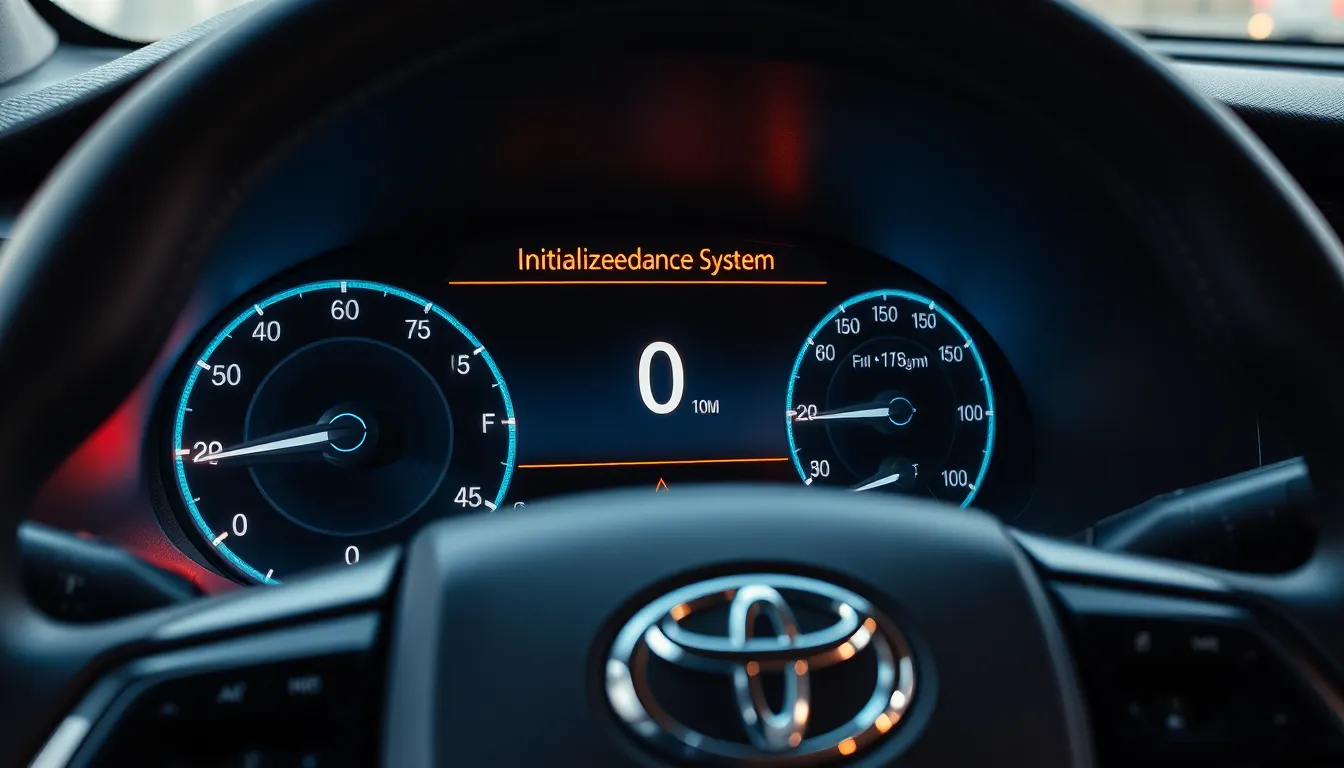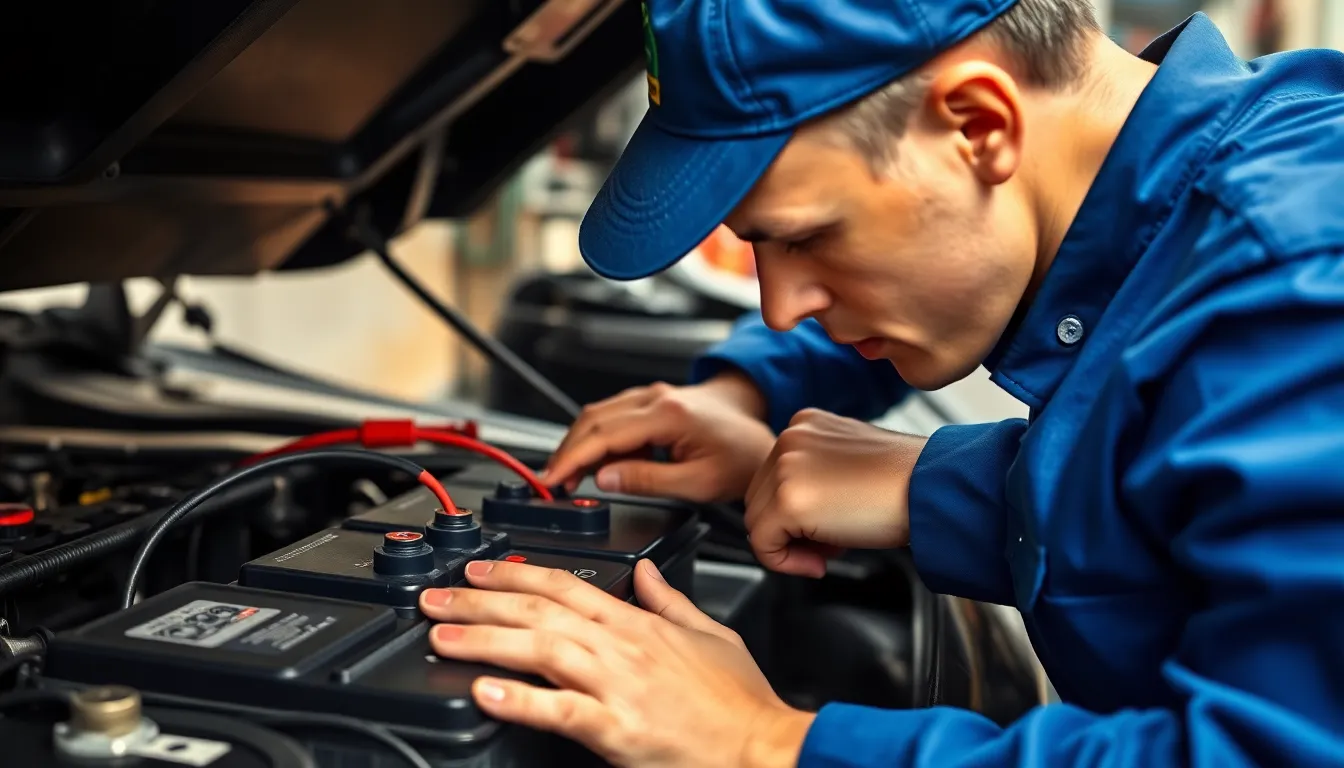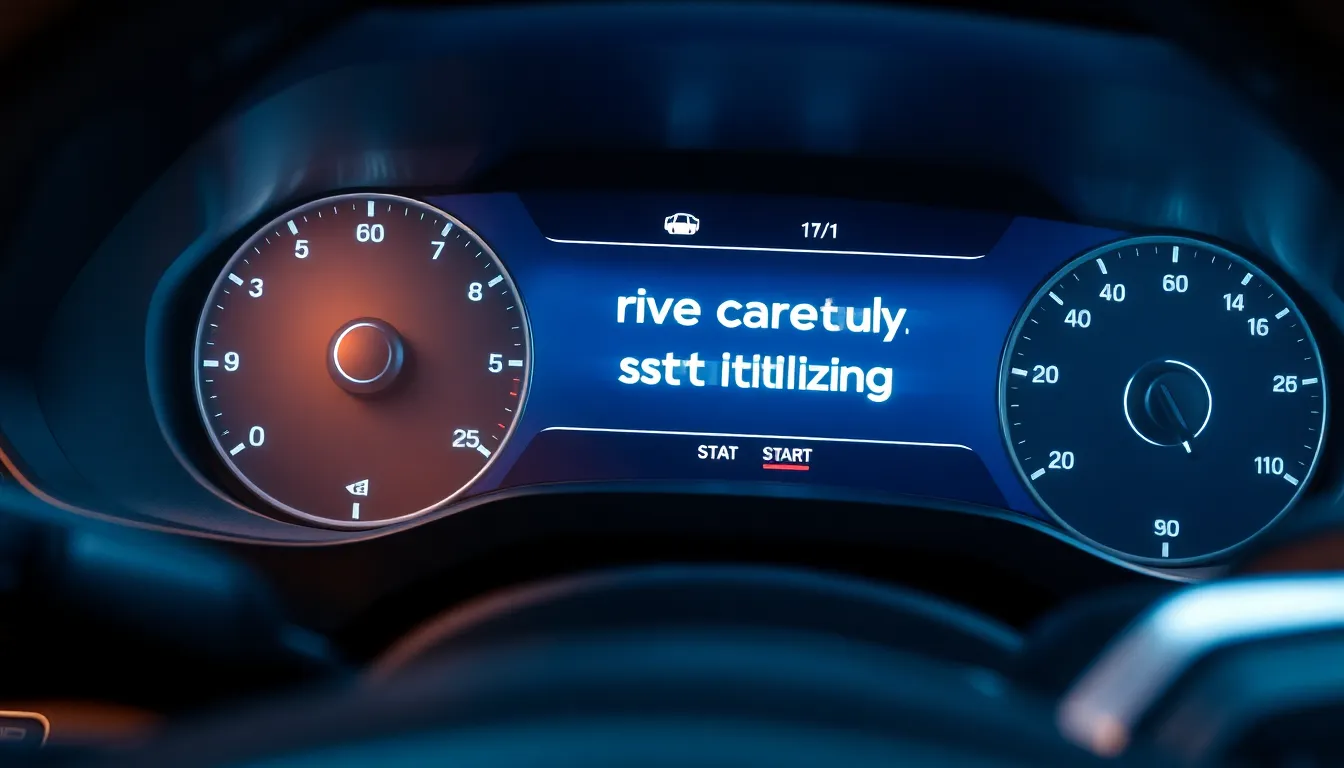We’ve all experienced that moment when we start our car and see the “Drive Carefully Systems Initializing” message flash across the dashboard. This modern automotive warning has become increasingly common as vehicles integrate more sophisticated safety technologies into their daily operations.
The message typically appears during startup as your vehicle’s advanced driver assistance systems (ADAS) run through their calibration process. These systems include everything from collision detection and lane departure warnings to adaptive cruise control and emergency braking features. While the initialization usually takes just seconds your car’s computer is performing complex diagnostics to ensure all safety components function properly.
Understanding what happens during this initialization process can help you make informed decisions about your vehicle’s safety features and know when something might need attention. We’ll explore why this message appears what systems are actually initializing and what you should do if the process takes longer than expected.
What Does “Drive Carefully Systems Initializing” Mean?
The “Drive Carefully Systems Initializing” message indicates your vehicle’s Advanced Driver Assistance Systems (ADAS) are performing startup diagnostics and calibration procedures. Modern vehicles display this warning when sophisticated safety technologies begin their operational checks during ignition.
System initialization encompasses multiple components working simultaneously:
- Adaptive cruise control sensors verify distance measurement accuracy
- Lane departure warning cameras calibrate road marking detection
- Automatic emergency braking systems test sensor responsiveness
- Blind spot monitoring radar units establish detection zones
- Electronic stability control modules verify gyroscope readings
Vehicle manufacturers program these systems to communicate with the Engine Control Unit (ECU) during startup sequences. Each ADAS component transmits status signals confirming operational readiness before the warning message disappears from your dashboard.
Initialization duration varies by vehicle make and complexity:
| Vehicle Type | Typical Duration | Systems Count |
|---|---|---|
| Basic ADAS | 3-5 seconds | 2-4 systems |
| Mid-level ADAS | 5-8 seconds | 5-7 systems |
| Advanced ADAS | 8-15 seconds | 8+ systems |
Temperature conditions affect initialization timing since cold weather extends sensor calibration periods. Electronic components require thermal stability before achieving optimal performance parameters.
Safety protocols prevent normal driving capabilities until initialization completes successfully. Your vehicle’s computer ensures all safety systems function correctly before removing the cautionary message and enabling full ADAS features.
Common Causes of System Initialization Messages

Several factors can trigger the “Drive Carefully Systems Initializing” message on your dashboard. Understanding these causes helps us identify when the message indicates normal operation versus potential system issues.
Cold Weather and Battery Issues
Cold temperatures affect system initialization timing and performance significantly. The message appears more frequently during winter months or after vehicles sit inactive for extended periods because electronic components require additional time to reach optimal operating temperatures.
Battery related problems create initialization delays in multiple ways. Disconnected battery terminals cause systems to lose stored calibration data and require complete reinitialization processes. Loose connections prevent proper voltage delivery to ADAS components during startup sequences.
Low battery voltage conditions force the vehicle’s computer to prioritize essential systems over advanced safety features. Cold weather reduces battery efficiency by 20 to 50 percent, which extends initialization times from the typical 3 to 5 seconds to 10 to 15 seconds in temperatures below freezing.
Software Updates and Recalibration
System updates trigger mandatory reinitialization cycles to ensure new software integrates properly with existing hardware. Manufacturers release ADAS updates quarterly to improve performance and address safety concerns, requiring vehicles to recalibrate sensors and cameras after installation.
Recalibration procedures become necessary after exact maintenance events. Windshield replacement disrupts camera positioning for lane departure systems and automatic emergency braking features. Wheel alignment services affect radar sensor angles used by adaptive cruise control and blind spot monitoring systems.
Power interruptions during software installations create incomplete update scenarios. Battery disconnection during service appointments forces systems to restart initialization sequences and verify all components function correctly with updated parameters.
Sensor Malfunction or Obstruction
Sensor obstructions prevent proper system initialization and generate persistent warning messages. Snow, ice, or dirt covering radar units behind bumpers blocks signal transmission and forces systems into safe mode until sensors receive adequate cleaning.
Camera malfunctions in windshield mounted units disrupt lane keeping assistance and forward collision warning systems. Moisture accumulation inside camera housings creates image distortion that prevents accurate object detection during initialization testing.
Wiring issues between sensors and control modules interrupt communication protocols essential for system validation. Loose connections cause intermittent signal loss that extends initialization times beyond normal parameters. Damaged wiring harnesses from road debris or corrosion prevent sensors from reporting operational status to the Engine Control Unit effectively.
Different Vehicle Brands and Their Initialization Processes

Vehicle manufacturers carry out unique initialization sequences that reflect their exact ADAS technologies and engineering approaches. Each brand’s systems require different timing and procedures to complete the startup calibration process.
Toyota and Lexus Systems
Toyota and Lexus vehicles complete their driver assistance system initialization through a straightforward calibration process that activates once the engine starts. These systems require drivers to maintain straight line movement for approximately 10 to 12 seconds to finish the sensor calibration and verification procedures. During this brief period, adaptive cruise control and lane keeping assist features remain temporarily inactive while the onboard computer establishes communication with all safety sensors.
The initialization message disappears automatically once the calibration sequence concludes, indicating that all driver assistance technologies are operational and ready for use. Toyota’s Safety Sense 2.0 and Lexus Safety System+ use this standardized approach across most model years to ensure consistent system performance.
Honda and Acura Warnings
Honda and Acura initialization procedures incorporate additional security measures that activate particularly after power interruptions or battery disconnection events. These vehicles often require drivers to input a 4 digit security code to unlock navigation and audio systems before the complete initialization sequence can proceed. GPS satellite acquisition and map alignment processes form critical components of Honda’s initialization, as these functions support both navigation accuracy and driver assist feature calibration.
The Honda Sensing suite and AcuraWatch systems perform comprehensive system checks that include sensor alignment verification and communication testing between individual components. Navigation system synchronization occurs simultaneously with safety system initialization, creating a more complex startup sequence compared to other manufacturers.
General Motors Vehicles
General Motors vehicles display the initialization message while conducting extensive system diagnostics and inter component communication verification procedures. GM’s initialization process includes active safety recall scanning and connectivity assessment of all integrated safety systems as part of the standard startup routine. The onboard computer performs comprehensive checks between sensors and control modules to ensure proper system calibration and operational readiness.
OnStar connectivity verification occurs during this initialization phase, along with StabiliTrak and other stability control system calibration procedures. GM’s approach emphasizes thorough system diagnostics that contribute to enhanced safety performance once the initialization sequence completes successfully.
How Long Does System Initialization Take?

System initialization typically completes within a few minutes during normal driving conditions. Most vehicles finish the calibration process after driving one to two miles at steady speeds between 35-40 mph.
Basic safety system checks resolve in 3-5 seconds under optimal conditions. Advanced driver assistance systems require 8-15 seconds for complete initialization. Cold weather extends these timeframes as electronic components reach optimal operating temperatures.
Exact calibration procedures vary by system type. Wheel speed sensors complete calibration in as little as 200 feet of driving. Certain sensors require drivers to maintain straight-line movement for 10-12 seconds to establish proper baseline readings.
Navigation and GPS systems demand longer initialization periods. These systems average less than 10 minutes for complete startup but can extend up to 45 minutes when searching for satellite signals. Poor satellite reception in covered areas or urban canyons increases initialization time significantly.
| System Type | Normal Duration | Extended Duration |
|---|---|---|
| Basic ADAS | 3-5 seconds | 30-60 seconds |
| Advanced ADAS | 8-15 seconds | 2-3 minutes |
| Navigation/GPS | Under 10 minutes | Up to 45 minutes |
| Wheel Speed Sensors | 200 feet of driving | 1-2 miles |
Battery disconnection or prolonged vehicle inactivity triggers extended initialization sequences. Cold weather reduces battery efficiency and causes data loss requiring multiple system recalibration. Extended periods without driving reset learned parameters forcing systems to reestablish baseline measurements.
Vehicles may prompt drivers to relocate for clearer satellite signals if GPS initialization exceeds 45 minutes. Systems that fail to complete initialization within normal timeframes often require ECU resets or OBD2 scanner interventions to clear error codes and restart the calibration process.
Safety Implications During Initialization Period

Driver assistance systems remain temporarily unavailable during the initialization process, creating critical safety gaps that require our immediate attention. Systems like adaptive cruise control, lane-keeping assist, and automatic emergency braking cannot provide their usual protective interventions while undergoing startup routines.
Primary Safety Concerns During Initialization:
| Safety Feature | Status During Initialization | Risk Level |
|---|---|---|
| Automatic Emergency Braking | Inactive | High |
| Lane Departure Warning | Non-functional | Medium |
| Adaptive Cruise Control | Unavailable | Medium |
| Blind Spot Monitoring | Disabled | High |
| Electronic Stability Control | Limited functionality | High |
Manual vehicle control becomes our complete responsibility when these systems display initialization messages. We cannot rely on automated safety interventions that normally activate during emergency situations. Full driver awareness and defensive driving techniques become essential until all systems confirm operational readiness.
Vehicle manufacturers recommend maintaining reduced speeds and increased following distances during the initialization period. We must avoid sudden lane changes, aggressive acceleration, and complex driving maneuvers until safety systems complete their startup sequences. Extra caution becomes particularly important in heavy traffic, adverse weather conditions, or unfamiliar driving environments.
Emergency response capabilities remain significantly compromised during system initialization periods lasting 10-12 seconds under normal conditions. Our reaction times must compensate for absent automated features that typically provide split-second interventions. Manual braking, steering corrections, and hazard recognition become our sole defense mechanisms against potential collisions.
Drivers bear complete liability for accidents occurring during initialization periods when safety systems remain non-operational. Insurance companies and legal authorities recognize that automated safety features weren’t available to prevent incidents during these brief but critical timeframes. We must exercise heightened vigilance until dashboard messages confirm full system activation.
Troubleshooting Steps When Systems Won’t Initialize

Systems that fail to complete initialization beyond normal timeframes require systematic troubleshooting approaches. We recommend following these proven procedures when standard initialization doesn’t complete within expected durations.
Basic Reset Procedures
Power cycling represents the first troubleshooting step for persistent initialization failures. Shut down the vehicle completely, remove the key or press the start button to power off, then wait 30 seconds before restarting. Electronic control units often resolve temporary glitches through complete power cycles.
ECU reset procedures clear stored error codes that prevent proper system initialization. Disconnect the negative battery terminal for 10-15 minutes to discharge the system completely. Reconnect the terminal and attempt initialization again, allowing sensors and control modules to restart their calibration sequences.
OBD2 scanner interventions provide diagnostic capabilities when basic resets prove ineffective. Connect an OBD2 scanner to clear fault codes related to ADAS components, then restart the vehicle to trigger fresh initialization attempts. Professional-grade scanners offer exact reset functions for individual sensor systems.
Manual sensor cleaning addresses physical obstructions that block proper calibration. Clean radar units, cameras, and sensors using appropriate cleaning answers, ensuring no dirt or moisture interferes with initialization processes. Check windshield areas around camera housings for cracks or chips that affect sensor visibility.
When to Seek Professional Help
Extended initialization periods exceeding manufacturer specifications indicate underlying system malfunctions requiring professional diagnosis. Contact certified technicians when systems consistently fail to initialize within 45 minutes or display persistent error messages during multiple restart attempts.
Hardware failure indicators such as unusual dashboard warning lights, error codes, or complete system non-responsiveness warrant immediate professional intervention. Avoid driving when safety systems display critical fault messages or remain completely inactive after extended troubleshooting.
Software update requirements often necessitate dealer-level programming tools for proper installation and calibration. Professional technicians possess specialized equipment to perform comprehensive system updates and sensor recalibration procedures that exceed basic reset capabilities.
Warranty considerations protect vehicle owners from expensive repair costs when systems fail within coverage periods. Document all troubleshooting attempts and contact authorized service centers promptly to maintain warranty protections for ADAS-related repairs and replacements.
Preventing Future Initialization Issues

Battery connections form the foundation of stable system initialization. We recommend inspecting and securing battery terminals regularly to prevent loose or corroded connections that disrupt power supply to vehicle electronics. Clean terminals ensure consistent voltage delivery during the critical startup sequence when ADAS components require maximum power stability.
Following OEM procedures eliminates unnecessary initialization cycles caused by incorrect maintenance practices. We always reference the vehicle manufacturer’s manual when performing repairs or diagnostics to avoid triggering repeated system resets. Each manufacturer designs exact sequences that optimize their ADAS technologies for reliable operation.
Security codes become essential after battery disconnection or power loss events. We keep documentation for navigation and other system codes in accessible locations since certain components require manual code entry for reinitialization. Entering these codes promptly restores full system functionality without extended delays.
Straight line driving completes sensor calibration for many vehicle systems. We maintain steady forward movement for 10 to 12 seconds after startup to allow proper initialization of lane keeping assist and adaptive cruise control sensors. This calibration period ensures accurate detection of road markings and surrounding vehicles.
OBD2 diagnostic tools identify system faults that cause persistent initialization messages. We scan vehicles regularly using these tools to clear error codes that prevent normal startup sequences. Regular diagnostic checks catch developing issues before they create extended initialization delays or complete system failures.
Vehicle software updates maintain compatibility between new features and existing hardware components. We schedule regular updates through authorized service centers to prevent initialization conflicts between different system versions. Updated software reduces calibration time and improves overall ADAS reliability during startup procedures.
| Prevention Method | Timeframe | Impact on Initialization |
|---|---|---|
| Battery terminal inspection | Monthly | Prevents power supply disruptions |
| OEM procedure compliance | Each service | Avoids incorrect reset triggers |
| Security code availability | As needed | Eliminates reinitialization delays |
| Straight line calibration | 10-12 seconds | Completes sensor alignment |
| OBD2 diagnostic scanning | Quarterly | Clears fault codes proactively |
| Software update scheduling | Per manufacturer | Maintains system compatibility |
These maintenance practices minimize system initialization frequency while ensuring reliable ADAS operation throughout the vehicle’s service life.
Conclusion
We’ve covered the essential aspects of the “Drive Carefully Systems Initializing” message and its role in modern vehicle safety. Understanding this process helps us drive more confidently while our car’s advanced systems come online.
Remember that initialization delays don’t always signal problems – they’re often normal responses to environmental conditions or routine maintenance. But staying alert during these periods remains crucial since our safety systems aren’t fully operational.
By following the troubleshooting steps and preventive measures we’ve outlined you’ll minimize initialization issues and keep your ADAS functioning reliably. When problems persist beyond normal timeframes don’t hesitate to consult professional technicians who can diagnose and resolve complex system failures.
Frequently Asked Questions
What does “Drive Carefully Systems Initializing” mean on my dashboard?
This message indicates your vehicle’s advanced driver assistance systems (ADAS) are undergoing a calibration process during startup. The car’s computer is performing diagnostics on safety components like adaptive cruise control, lane departure warning, and automatic emergency braking systems to ensure they’re functioning properly before enabling normal driving capabilities.
How long does system initialization typically take?
Basic ADAS systems usually initialize within 3-5 seconds under optimal conditions, while advanced systems may take 8-15 seconds. However, factors like cold weather, battery issues, or software updates can extend this process to 30-60 seconds for basic systems or 2-3 minutes for advanced systems.
Why is my system initialization taking longer than usual?
Extended initialization times often result from cold weather affecting battery efficiency, battery-related problems like low voltage or disconnected terminals, software updates requiring recalibration, sensor obstructions from dirt or moisture, or wiring issues between sensors and control modules. Temperature conditions and recent power interruptions can also cause delays.
Is it safe to drive while systems are initializing?
During initialization, driver assistance features like automatic emergency braking, lane departure warning, and adaptive cruise control are temporarily unavailable. You should maintain reduced speeds, increase following distances, avoid sudden maneuvers, and exercise heightened vigilance until all systems confirm operational readiness, as you bear full responsibility for vehicle control.
What should I do if initialization exceeds 45 minutes?
If systems fail to initialize within 45 minutes, try basic troubleshooting like power cycling the vehicle or performing an ECU reset by disconnecting the battery. Clean sensors manually to remove obstructions. If these steps don’t work, use an OBD2 scanner to clear fault codes or seek professional help for potential hardware failures.
Do different car brands have unique initialization processes?
Yes, each manufacturer implements distinct initialization sequences. Toyota and Lexus require straight-line movement for 10-12 seconds, Honda and Acura may need security code input after power interruptions, while General Motors vehicles conduct extensive diagnostics and connectivity assessments. Navigation systems can take up to 45 minutes in areas with poor satellite reception.
How can I prevent future initialization issues?
Regularly inspect and secure battery terminals, follow OEM procedures to prevent unnecessary resets, maintain documentation for security codes, practice straight-line driving for sensor calibration, schedule regular OBD2 diagnostic scans, and ensure software updates are performed at authorized service centers to maintain compatibility between hardware and software components.

